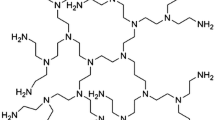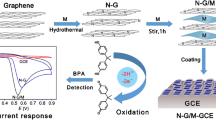Abstract
A sensitive electrochemical sensor was proposed via combining molecular imprinting technique with the graphene material-doped titanium nitride. The novel graphene with 3-dimensional structure displayed more binding sites and better electrochemical properties. Moreover, this study focused on coating pyrrole with electrical conductivity on the surface of silica as a monomer, and BPA as the template. The interaction made specific detection possible, between monomer and template. With a series of characterizations and electrochemical measurements, CPE (carbon paste electrode)-contained TiN-rGO composite was proved to have conductivity improved. Also, the modified polymer performed well selectivity which reflected in that it was almost impervious to distractions. Under optimized conditions, a linear dependence was observed from 0.5 to 100 nmol L−1 with a detection limit of 0.19 nmol L−1. The sensor explicated outstanding repeatability via repetitive experiment with the RSD of 0.02%, while the results of stability experiment reached the RSD of 1.90%. Eventually, it was used to analyze BPA residues in 3 kinds of daily supplies. The results indicated the potential of the sensor in environmental detection prospectively.







Similar content being viewed by others
Change history
03 December 2020
Springer Nature’s version of this paper was updated to present the correct copyright year.
References
Zhang Y, Mi K, Xue W, Wei W, Yang H. Acute BPA exposure-induced oxidative stress, depressed immune genes expression and damage of hepatopancreas in red swamp crayfish Procambarus clarkii. Fish Shellfish Immunol. 2020;103:95–102. https://doi.org/10.1016/j.fsi.2020.04.032.
Xie P, Ho SH, Peng J, Xu XJ, Chen C, Zhang ZF, et al. Dual purpose microalgae-based biorefinery for treating pharmaceuticals and personal care products (PPCPs) residues and biodiesel production. Sci Total Environ. 2019;688:253–61. https://doi.org/10.1016/j.scitotenv.2019.06.062.
In S, Yoon HW, Yoo JW, Cho H, Kim RO, Lee YM. Acute toxicity of bisphenol A and its structural analogues and transcriptional modulation of the ecdysone-mediated pathway in the brackish water flea Diaphanosoma celebensis. Ecotoxicol Environ Saf. 2019;179:310–7. https://doi.org/10.1016/j.ecoenv.2019.04.065.
Hercog K, Maisanaba S, Filipic M, Sollner-Dolenc M, Kac L, Zegura B. Genotoxic activity of bisphenol A and its analogues bisphenol S, bisphenol F and bisphenol AF and their mixtures in human hepatocellular carcinoma (HepG2) cells. Sci Total Environ. 2019;687:267–76. https://doi.org/10.1016/j.scitotenv.2019.05.486.
Goeury K, Vo Duy S, Munoz G, Prevost M, Sauve S. Analysis of Environmental Protection Agency priority endocrine disruptor hormones and bisphenol A in tap, surface and wastewater by online concentration liquid chromatography tandem mass spectrometry. J Chromatogr A. 2019;1591:87–98. https://doi.org/10.1016/j.chroma.2019.01.016.
Bilal M, Iqbal HMN, Barcelo D. Mitigation of bisphenol A using an array of laccase-based robust bio-catalytic cues - a review. Sci Total Environ. 2019;689:160–77. https://doi.org/10.1016/j.scitotenv.2019.06.403.
Wade M, Delawder V, Reneau P, Dos Santos JM. The effect of BPA exposure on insulin resistance and type 2 diabetes - the impact of muscle contraction. Med Hypotheses. 2020;140:109675. https://doi.org/10.1016/j.mehy.2020.109675.
Venisse N, Cambien G, Robin J, Rouillon S, Nadeau C, Charles T, et al. Development and validation of an LC–MS/MS method for the simultaneous determination of bisphenol A and its chlorinated derivatives in adipose tissue. Talanta. 2019;204:145–52. https://doi.org/10.1016/j.talanta.2019.05.103.
Pechancová R, Gallo J, Milde D, Pluháček T. Ion-exchange HPLC-ICP-MS: a new window to chromium speciation in biological tissues. Talanta. 2020;218:121150. https://doi.org/10.1016/j.talanta.2020.121150.
Richardson A, Antonopoulos GA. Anabolic-androgenic steroids (AAS) users on AAS use: negative effects, ‘code of silence’, and implications for forensic and medical professionals. J Forensic Legal Med. 2019;68:101871. https://doi.org/10.1016/j.jflm.2019.101871.
Dong B, Li H, Sun J, Mujtaba Mari G, Ai J, Han D, et al. Homogeneous fluorescent immunoassay for the simultaneous detection of chloramphenicol and amantadine via the duplex FRET between carbon dots and WS2 nanosheets. Food Chem. 2020;327:127107. https://doi.org/10.1016/j.foodchem.2020.127107.
Wei G, Lu Y, Liu S, Li H, Liu X, Ye G, et al. Microplasma electrochemistry (MIPEC) strategy for accelerating the synthesis of metal organic frameworks at room temperature. Chin Chem Lett. 2020. https://doi.org/10.1016/j.cclet.2020.04.019.
Ke X. Micro-fabricated electrochemical chloride ion sensors: from the present to the future. Talanta. 2020;211:120734. https://doi.org/10.1016/j.talanta.2020.120734.
Zhang Z, Zhao X, Liu J, Yin J, Cao X. Highly sensitive sandwich electrochemical sensor based on DNA-scaffolded bivalent split aptamer signal probe. Sensors Actuators B Chem. 2020;311:127920. https://doi.org/10.1016/j.snb.2020.127920.
Yang W, Qing Y, Cao Y, Luan Y, Lu Y, Liu T, et al. A stimuli response, core-shell structured and surface molecularly imprinted polymers with specific pH for rapid and selective detection of sulfamethoxazole from milk sample. React Funct Polym. 2020;151:104578. https://doi.org/10.1016/j.reactfunctpolym.2020.104578.
Huang W, Zhou X, Luan Y, Cao Y, Wang N, Lu Y, et al. A sensitive electrochemical sensor modified with multi-walled carbon nanotubes doped molecularly imprinted silica nanospheres for detecting chlorpyrifos. J Sep Sci. 2020;43(5):954–61. https://doi.org/10.1002/jssc.201901036.
Xu W, Gao M, Yin X, Zhang L, Cao Y, Zhang Y, et al. Photo-stimulated “turn-on/off” molecularly imprinted polymers based on magnetic mesoporous silicon surface for efficient detection of sulfamerazine. J Sep Sci. 2020;43(13):2550–7. https://doi.org/10.1002/jssc.202000043.
Zheng W, Xiong Z, Li H, Yu S, Li G, Niu L, et al. Electrodeposited Pt@Molecularly imprinted polymer core-shell nanostructure: enhanced sensing platform for sensitive and selective detection of bisphenol A. Sensors Actuators B Chem. 2018;272:655–61. https://doi.org/10.1016/j.snb.2018.07.039.
Sun Y, He J, Waterhouse GIN, Xu L, Zhang H, Qiao X, et al. A selective molecularly imprinted electrochemical sensor with GO@COF signal amplification for the simultaneous determination of sulfadiazine and acetaminophen. Sensors Actuators B Chem. 2019;300:126993. https://doi.org/10.1016/j.snb.2019.126993.
Shetti NP, Malode SJ, Ilager D, Raghava Reddy K, Shukla SS, Aminabhavi TM. A novel electrochemical sensor for detection of molinate using ZnO nanoparticles loaded carbon electrode. Electroanalysis. 2019;31(6):1040–9. https://doi.org/10.1002/elan.201800775.
Dakshayini BS, Reddy KR, Mishra A, Shetti NP, Malode SJ, Basu S, et al. Role of conducting polymer and metal oxide-based hybrids for applications in ampereometric sensors and biosensors. Microchem J. 2019;147:7–24. https://doi.org/10.1016/j.microc.2019.02.061.
Muratsugu S, Shirai S, Tada M. Recent progress in molecularly imprinted approach for catalysis. Tetrahedron Lett. 2020;61(11):151603. https://doi.org/10.1016/j.tetlet.2020.151603.
Li S, Pang C, Ma X, Li H, Zhao M, Liu C, et al. A gold nanoparticle-loaded molecularly imprinted switch sensor with high sensitivity to ethephon. Microchem J. 2020;157:105025. https://doi.org/10.1016/j.microc.2020.105025.
Zhang Y, Huang W, Yin X, Sarpong KA, Zhang L, Li Y, et al. Computer-aided design and synthesis of molecular imprinting polymers based on doubly oriented functional multiwalled carbon nanotubes for electrochemically sensing bisphenol A. React Funct Polym. 2020;104767. https://doi.org/10.1016/j.reactfunctpolym.2020.104767.
Arabi M, Ostovan A, Bagheri AR, Guo X, Wang L, Li J, et al. Strategies of molecular imprinting-based solid-phase extraction prior to chromatographic analysis. TrAC Trends Anal Chem. 2020;115923. https://doi.org/10.1016/j.trac.2020.115923.
Rebelo T, Costa R, Brandao A, Silva AF, Sales MGF, Pereira CM. Molecularly imprinted polymer SPE sensor for analysis of CA-125 on serum. Anal Chim Acta. 2019;1082:126–35. https://doi.org/10.1016/j.aca.2019.07.050.
Ali H, Mukhopadhyay S, Jana NR. Selective electrochemical detection of bisphenol A using a molecularly imprinted polymer nanocomposite. New J Chem. 2019;43(3):1536–43. https://doi.org/10.1039/c8nj05883k.
Cheng JP, Wang WD, Wang XC, Liu F. Recent research of core–shell structured composites with NiCo2O4 as scaffolds for electrochemical capacitors. Chem Eng J. 2020;393:124747. https://doi.org/10.1016/j.cej.2020.124747.
Cruz-Medina R, Vega-Rios A, Hernández-Escobar CA, Estrada-Monje A, Rodríguez-Sánchez I, Armando Z-CE. Polystyrene-polyaniline core-shell composite particles using a bifunctional selectively polymerizable monomer as the interfacial linkage. Synth Met. 2020;265:116402. https://doi.org/10.1016/j.synthmet.2020.116402.
Ma W, Row KH. Solid-phase extraction of chlorophenols in seawater using a magnetic ionic liquid molecularly imprinted polymer with incorporated silicon dioxide as a sorbent. J Chromatogr A. 2018;1559:78–85. https://doi.org/10.1016/j.chroma.2018.01.013.
Shuai HL, Wu X, Huang KJ, Zhai ZB. Ultrasensitive electrochemical biosensing platform based on spherical silicon dioxide/molybdenum selenide nanohybrids and triggered hybridization chain reaction. Biosens Bioelectron. 2017;94:616–25. https://doi.org/10.1016/j.bios.2017.03.058.
Leonard KC, Genthe JR, Sanfilippo JL, Zeltner WA, Anderson MA. Synthesis and characterization of asymmetric electrochemical capacitive deionization materials using nanoporous silicon dioxide and magnesium doped aluminum oxide. Electrochim Acta. 2009;54(22):5286–91. https://doi.org/10.1016/j.electacta.2009.01.082.
Eslami M, Deflorian F, Zanella C. Electrochemical performance of polypyrrole coatings electrodeposited on rheocast aluminum-silicon components. Prog Org Coat. 2019;137:105307. https://doi.org/10.1016/j.porgcoat.2019.105307.
Zhou Q, Zhou Y, Bao M, Ni X. Modified silicon nanowires@polypyrrole core-shell nanostructures by poly(3,4-ethylenedioxythiophene) for high performance on-chip micro-supercapacitors. Appl Surf Sci. 2019;487:236–43. https://doi.org/10.1016/j.apsusc.2019.05.114.
Bai X, Zhang B, Liu M, Hu X, Fang G, Wang S. Molecularly imprinted electrochemical sensor based on polypyrrole/dopamine@graphene incorporated with surface molecularly imprinted polymers thin film for recognition of olaquindox. Bioelectrochemistry. 2020;132:107398. https://doi.org/10.1016/j.bioelechem.2019.107398.
Oliveira SM, Luzardo JM, Silva LA, Aguiar DC, Senna CA, Verdan R, et al. High-performance electrochemical sensor based on molecularly imprinted polypyrrole-graphene modified glassy carbon electrode. Thin Solid Films. 2020;699:137875. https://doi.org/10.1016/j.tsf.2020.137875.
Bahar N, Ekinci D. Hollow porous gold nanoparticle/reduced graphene oxide composite films for electrochemical supercapacitor applications. Electrochim Acta. 2020;337:135844. https://doi.org/10.1016/j.electacta.2020.135844.
Zhang J, Nan L, Yue W, Chen X. Enhanced methanol electro-oxidation activity of electrochemically exfoliated graphene-Pt through polyaniline modification. J Electroanal Chem. 2020;858:113821. https://doi.org/10.1016/j.jelechem.2020.113821.
Zhang MG, Smith A, Gorski W. Carbon nanotube-chitosan system for electrochemical sensing based on dehydrogenase enzymes. Anal Chem. 2004;76(17):5045–50. https://doi.org/10.1021/ac049519u.
El-Hossary FM, Negm NZ, Abd El-Rahman AM, Raaif M, Seleem AA, Abd El-Moula AA. Tribo-mechanical and electrochemical properties of plasma nitriding titanium. Surf Coat Technol. 2015;276:658–67. https://doi.org/10.1016/j.surfcoat.2015.06.003.
You H, Shi M, Hao J, Min H, Yang H, Liu X. A spongy mesoporous titanium nitride material as sulfur host for high performance lithium-sulfur batteries. J Alloys Compd. 2020;823:153879. https://doi.org/10.1016/j.jallcom.2020.153879.
Xu C, Qiu G, Ng SP, Lawrence Wu C-M. Nanostructured titanium nitride for highly sensitive localized surface plasmon resonance biosensing. Ceram Int. 2020. https://doi.org/10.1016/j.ceramint.2020.05.163.
Chen X, Li W, Xu Y, Zeng Z, Tian H, Velayutham M, et al. Charging activation and desulfurization of MnS unlock the active sites and electrochemical reactivity for Zn-ion batteries. Nano Energy. 2020;104869. https://doi.org/10.1016/j.nanoen.2020.104869.
Hampitak P, Melendrez D, Iliut M, Fresquet M, Parsons N, Spencer B, et al. Protein interactions and conformations on graphene-based materials mapped using quartz-crystal microbalance with dissipation monitoring (QCM-D). Carbon. 2020;165:317–27. https://doi.org/10.1016/j.carbon.2020.04.093.
Lancellotti L, Bobeico E, Della Noce M, Mercaldo LV, Usatii I, Delli Veneri P, et al. Graphene as non conventional transparent conductive electrode in silicon heterojunction solar cells. Appl Surf Sci. 2020;525:146443. https://doi.org/10.1016/j.apsusc.2020.146443.
Wei P, Zhu Z, Song R, Li Z, Chen C. An ion-imprinted sensor based on chitosan-graphene oxide composite polymer modified glassy carbon electrode for environmental sensing application. Electrochim Acta. 2019. https://doi.org/10.1016/j.electacta.2019.05.136.
El-badawy FM, Mohamed MA, El-Desoky HS. Fabrication of an electrochemical sensor based on manganese oxide nanoparticles supported on reduced graphene oxide for determination of subnanomolar level of anti-hepatitis C daclatasvir in the formulation and biological models. Microchem J. 2020;157:104914. https://doi.org/10.1016/j.microc.2020.104914.
Sanati A, Raeissi K, Karimzadeh F. A cost-effective and green-reduced graphene oxide/polyurethane foam electrode for electrochemical applications. FlatChem. 2020;20:100162. https://doi.org/10.1016/j.flatc.2020.100162.
Zhan Y, Edison E, Manalastas W, Tan MRJ, Satish R, Buffa A, et al. Electrochemical deposition of highly porous reduced graphene oxide electrodes for Li-ion capacitors. Electrochim Acta. 2020;337:135861. https://doi.org/10.1016/j.electacta.2020.135861.
Hummers WS Jr, Offeman RE. Preparation of graphitic oxide. J Am Chem Soc. 1958;80:1339.
Stöber W, Fink A, Bohn E. Controlled growth of monodisperse silica spheres in the micron size range. J Colloid Interface Sci. 1968;26:62–9.
Bagheri H, Khoshsafar H, Afkhami A, Amidi S. Sensitive and simple simultaneous determination of morphine and codeine using a Zn2SnO4 nanoparticle/graphene composite modified electrochemical sensor. New J Chem. 2016;40(8):7102–12. https://doi.org/10.1039/c6nj00505e.
Funding
This work was financially supported by the National Natural Science Foundation of China (No. 21677064), Science and Technology Planning Social Development Project of Jiangsu Province (No. BE2018694), Science and Technology Planning Social Development Project of Zhenjiang City (Nos. SH2018015, SH2019013), the Fifth phase “169 Project” training fund of Zhenjiang and Jiangsu Collaborative Innovation Center of Technology and Material of Water Treatment.
Author information
Authors and Affiliations
Corresponding authors
Ethics declarations
Conflict of interest
The authors declare that they have no conflict of interest.
Additional information
Publisher’s note
Springer Nature remains neutral with regard to jurisdictional claims in published maps and institutional affiliations.
Supplementary information
ESM 1
(PDF 958 kb)
Rights and permissions
About this article
Cite this article
Xu, W., Zhang, Y., Yin, X. et al. Highly sensitive electrochemical BPA sensor based on titanium nitride-reduced graphene oxide composite and core-shell molecular imprinting particles. Anal Bioanal Chem 413, 1081–1090 (2021). https://doi.org/10.1007/s00216-020-03069-7
Received:
Revised:
Accepted:
Published:
Issue Date:
DOI: https://doi.org/10.1007/s00216-020-03069-7




